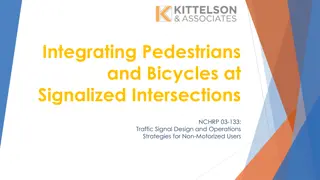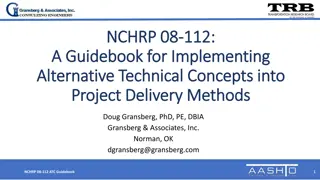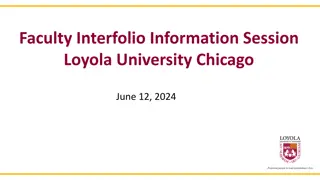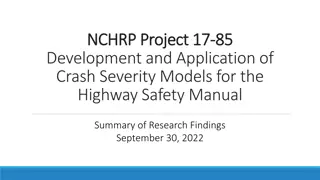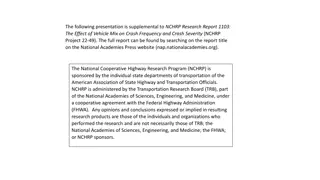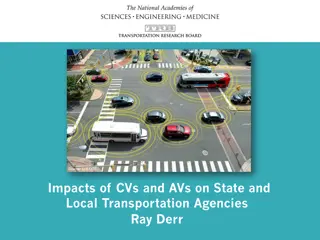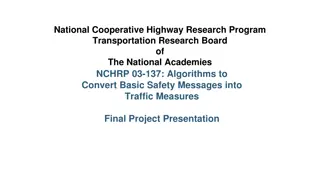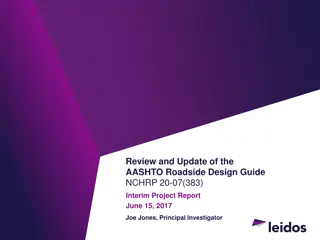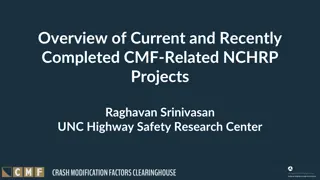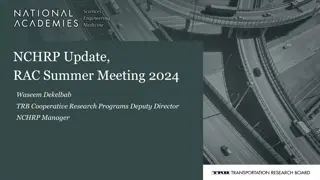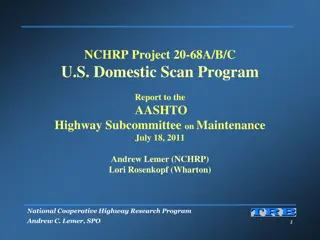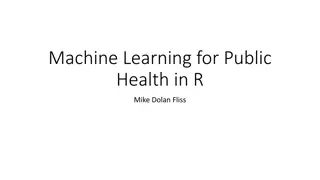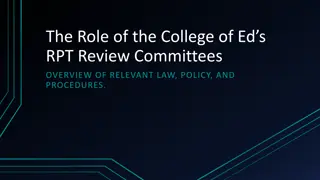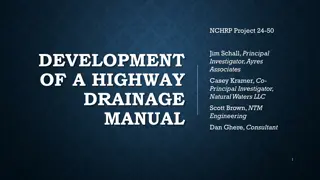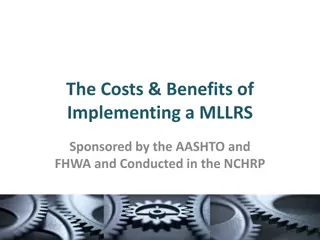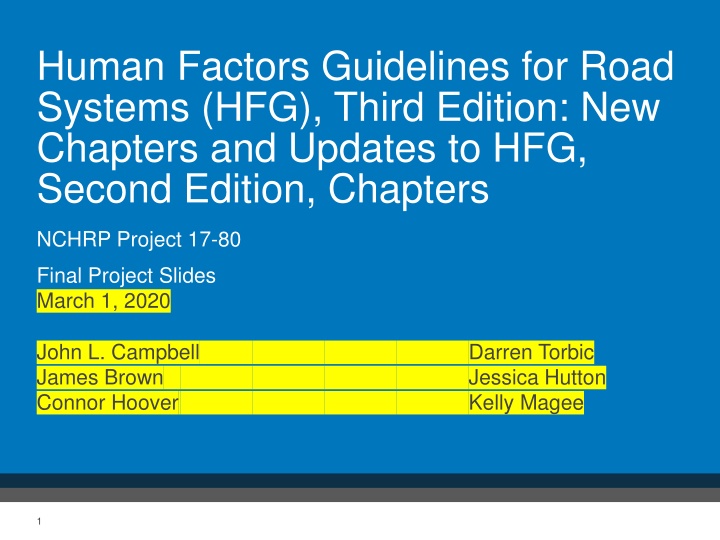
Developing Human Factors Guidelines for Road Systems: Objectives and Tasks
Explore the objectives and tasks involved in preparing the Third Edition of Human Factors Guidelines for Road Systems, which aims to incorporate user feedback and research for enhancing road system usability. Tasks include developing a user feedback plan and evaluating the quality and relevance of the current guidelines.
Download Presentation

Please find below an Image/Link to download the presentation.
The content on the website is provided AS IS for your information and personal use only. It may not be sold, licensed, or shared on other websites without obtaining consent from the author. If you encounter any issues during the download, it is possible that the publisher has removed the file from their server.
You are allowed to download the files provided on this website for personal or commercial use, subject to the condition that they are used lawfully. All files are the property of their respective owners.
The content on the website is provided AS IS for your information and personal use only. It may not be sold, licensed, or shared on other websites without obtaining consent from the author.
E N D
Presentation Transcript
Human Factors Guidelines for Road Systems (HFG), Third Edition: New Chapters and Updates to HFG, Second Edition, Chapters NCHRP Project 17-80 Final Project Slides March 1, 2020 John L. Campbell James Brown Connor Hoover Darren Torbic Jessica Hutton Kelly Magee 1
Introduction to the HFG The HFG Contains: Introduction (Why human factors guidelines and how to use the document) Bringing road user capabilities to highway and traffic engineering practice Human Factors guidance for roadway location elements (2-page guidelines related to geometric elements) Human Factors guidance for traffic engineering elements (2-page guidelines related to signs, markings, etc.) Tutorials (free-form, detailed discussions about selected topics) Back matter (references, glossary, index, abbreviations, and equations) 2
Objectives 1. To prepare a ThirdEdition Human Factors Guidelines for Road Systems (HFG) based on updated and expanded guidelines 2. Synthesize and incorporate relevant ongoing and completed research, related documents, and user feedback in order to expand the scope and quality of the HFG to increase application and improve usability 3. Employ a format and design similar to the Second Edition HFG (though consider and implement, as appropriate, modifications to format and style or design). 3
Task 4: Develop and Implement a User Feedback Plan Scope: Develop and implement a plan to obtain user feedback to identify key criteria to be considered and detail acceptance criteria for content to be included in the Third Edition HFG. Approach: Identify HFG users and potential participants in the feedback survey. Develop the individual survey items Identify the means to conduct the survey Develop a work plan to conduct the survey Implement the survey Goal was to obtain responses from 300 individuals 5
Task 4: Develop and Implement a User Feedback Plan - Survey Demographics and job responsibilities (Questions 1-5) One question on the respondent s level of familiarity with the HFG (Question 6) Based on their response to Question 6, respondents received the full survey if they reported familiarity with the HFG (21 additional questions). Those who reported they were unfamiliar with the HFG received a truncated version of the survey (5 additional questions) Whether the formatting, content, and references of the current HFG are meeting user s needs and the quality of the HFG relative to other common reference guides (Questions 7-13) What types of design issues or problems users apply the HFG to and which chapters are the most/least useful (Questions 14-19) What new topics should be added in the update and additional formatting and content changes to consider in the current and future updates (Questions 20- 27) 6
Task 4: Develop and Implement a User Feedback Plan Who Responded? 258 respondents Avg.=19 years of experience Primary Responsibilities: Traffic Safety - 53% Traffic/Transportation Studies - 43% Roadway Design/Engineering - 41% Planning - 36.3 Operations - 28.2 Human Factors - 21.2% 7
Task 4: Develop and Implement a User Feedback Plan Key Results Positive feedback for ease-of-use, clarity, & overall value The majority of respondents rate the HFG as equivalent to or better than other design guides. High interest in: cross-referencing to other guides, an interactive web-based application version of the HFG and broader coverage of traffic operations topics. New topics for inclusion were remarkably consistent between both users and non-users of the HFG. The top four selections for both groups were Pedestrians, Bicycles, Older Road Users, and Roundabouts. 8
Task 4: Develop and Implement a User Feedback Plan Applied the HFG? If yes: How did it help? Countermeasure selection Help with RSAs Referenced support for conclusions Roadway Signage Review Help when exception from standards is needed Sign evaluations, retroreflectivity, markings, sight distance, speed perception and choice Training & teaching Crash causality 9
Task 4: Develop and Implement a User Feedback Plan Applied the HFG? If no: Why not? Potential conflict with current standards The HFG should better explain why & how HFs influence driving performances & road design Does not include crash frequency reductions Clients/agencies not using it lack of familiarity Not applicable to job responsibilities Not enough research on bicycle facility design Not enough time to include an additional tool No opportunity yet 10
Task 4: Develop and Implement a User Feedback Plan Key Results 11
Task 5: Conduct Initial Literature Review to Identify Potential Guideline Content Chapter Title High Priority Medium Priority Low Priority New New New New New Bicyclists Pedestrians Roundabouts Motorcycles Older Road Users * * New Road Diet/Complete Streets Connected/Automated Vehicles Heavy Vehicles New New * New Transit *This new information will likely be included as updates to existing chapters and components of some new chapters rather than as a stand-alone chapter. 12
Task 5: Conduct Initial Literature Review to Identify Potential Guideline Content Chapter Title High Priority Medium Priority Low Priority 5 6 Sight Distance Curves (Horizontal Alignment) Grades (Vertical Alignment) Tangent Sections and Roadside Transition Zones 7 8 9 10 Non-Signalized Intersections Signalized Intersections Interchanges 11 12 13 Construction and Work Zones 13
Task 5: Conduct Initial Literature Review to Identify Potential Guideline Content Chapter Title High Priority Medium Priority Low Priority 14 Rail-Highway Grade Crossings Special Considerations for Urban Environments Special Considerations for Rural Environments Speed Perception, Speed Choice, & Speed Control Signing 15 16 17 18 19 Changeable Message Signs Markings 20 21 Lighting 14
Status of New Chapters and Updates Chapter Title Number of Guidelines 9 8 6 Status New New New Pedestrians Bicyclists Roundabouts Completed Completed Completed 5 Sight Distance Non-Signalized Intersections 2 Updated Completed 1 New 3 Updated 10 Completed 11 Signalized Intersections Future Speed Perception, Speed Choice, & Speed Control 20, 6, 21 Marking, Curves, Lighting 17 Future Future Need to make decision to include Older Road Users as a new chapter or as additional guidelines within relevant chapters. 15
New Chapter: Pedestrians Guidelines for the Pedestrians chapter include: Task Analysis of Pedestrian Crossing In a Multi-Threat Scenario 1. Countermeasures to Reduce Pedestrian Exposure to Vehicles at Crossings 2. Speed-Calming Countermeasures at Crosswalks 3. Improving Pedestrian Visibility and Conspicuity at Crosswalks 4. Selecting Beacons to Improve Pedestrian Conspicuity at Crosswalks 5. Influence of the Built Environment on Pedestrian Crossing Safety 6. Design Challenges for Older Pedestrians 7. Pedestrian Rail Crossing Safety 8. Key References for Pedestrian Crossing Safety Countermeasures 9. 16
New Chapter: Bicyclists Guidelines for the Bicyclists chapter include: Signals and Signal Timing for Bicycles at Intersections 1. Markings for Bicycles at Intersections 2. Bicycle Lanes 3. Separated Bicycle Lanes 4. Contraflow Bicycle Lanes 5. Shared Use Lanes 6. Bus-Bicycle Shared Lanes 7. Mitigating Heavy Vehicle Conflicts with Bicycles 8. 17
New Chapter: Roundabouts (Completed) Guidelines for the Roundabouts chapter include: Reducing Vehicle Speeds Approaching Roundabouts 1. Increasing Driver Yielding Rates for Pedestrians at Roundabouts 2. GuideSigning at Roundabouts 3. Accommodations for Bicyclists at Roundabouts 4. Countermeasures for Improving Accessibility for Visually Impaired Pedestrians at Roundabouts* 5. Roundabout Lighting 6. * Substantial update moved from Non-Signalized Intersections 18
Updates for Existing Chapters Introductory Materials Chapter 1: Updated relevant sections Chapter 2: Planned, but nothing substantive was identified or included Chapter 5 Sight Distance 2 Existing guidelines updated with new sources and information Guideline information related to current standards (e.g., MUTCD and Green Book) verified to ensure consistency, and references updated Chapter 10 Non-signalized Intersections: In process New guideline about left-turn lanes Existing guidelines updated with new sources and information Guideline information related to current standards (e.g., MUTCD and Green Book) verified to ensure consistency, and references updated 19
New Tutorials Three new tutorials: Summary of HFG Topics: Completed Using the HFG to Support Road Safety Audits: Completed Joint Use of the HSM and the HFG: Completed One planned tutorials abandoned Using the HFIM to conduct Diagnostic Assessments The information planned for this tutorial was included in the Joint Use of HSM and the HFG tutorial instead 20

